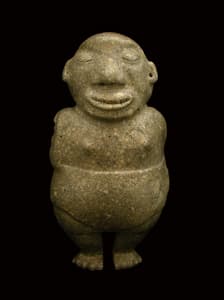Stone Sculpture of a Dwarf, 300 BCE - 500 CE
Green Stone
12.5
PF.3827
Further images
This figure represents a dwarf with the added deformity of missing arms. Around the broad waist a wide covering extends beyond the navel and cuts upwards from the groin at...
This figure represents a dwarf with the added deformity of missing arms. Around the broad waist a wide covering extends beyond the navel and cuts upwards from the groin at an angle over the middle thighs. Short legs and small feet are modeled in a way to give fine balance to the heavy torso. His ovular head reaches nearly to the edge of the shoulders, his nose is very large and fleshy, the grinning mouth reveals a row of well-proportioned teeth. Most significantly, the eyes are depicted in such a way as to suggest both being closed and open, as if through a narrow slit below the lids he is watching us. Around the neck is a pattern of inverted connecting triangles, in a design bringing to mind jesters of Europe. Dwarfs, hunchbacks and others with physical deformities were regarded with esteem in Meso-America; seen as individuals possessing magical powers. The power of this sculpture lies in its depiction of a person afflicted that shows grace, dignity and a gentle beauty.
Literature
V20





